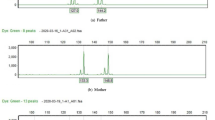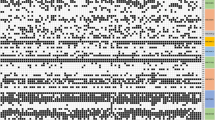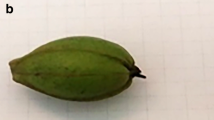Abstract
Sequence-related amplified polymorphism (SRAP) is a new molecular marker technology developed based on polymerase chain reaction. The authenticity of 84 progenies of 8 hybrid combinations of Stylosanthes guianensis was identified by SRAP markers to select the true hybrids used in the present study. A total of 35 SRAP primer combinations were selected from the parents of 8 hybrid combinations. The selected polymorphism primer combinations were applied to identify the authenticity of all progenies. The male parents of the primer combinations had specific markers, whereas the female parents did not. 68 progenies exhibited male parent-specific bands, which were identified as true hybrids. The rest of the progenies were considered self-hybrids because of the absence of male parent-specific bands. The results of hybrid identification provided solid evidence for further studies of hybrids and demonstrated SRAP molecular markers as a useful technology for assessing the purity of S. guianensis hybrids.


Similar content being viewed by others

References
Costa NMS, Ferreira MB (1984) Some Brazilian species of Stylosanthes. In: Stace HM, Edye LA (eds) The biology and agronomy of Stylosanthes. Academic Press, Sydney, pp 53–101
Williams RJ, Reid R, Schhult ze-Kraft R et al (1984) Natural distribution of Stylosanthes. In: S tace HM, Edye LA (eds) The biology and agronomy of Stylosanthes. Sydney, Academic Press, pp 73–101
Vieira MLC, Aguiar-perecin MLR, Martins PS (1993) A cytotaxonomic study in twelve Brazilian taxa of Stylosanthes Sw Leguminosae. Cytologia 58:305–311
Burt RL, Miller CP (1975) Stylosanthes—a source of pasture legumes. Trop grasslands 9:117–123
Hwang MY, Wun LX, Zhang CZ (1986) The main varieties of forages and their evaluation in Southern China. In: proceedings of an international workshop, Cisarua, Indonesia, 19–23 August, 1985. p.202. (ACIAR Proceedings Series No.12)
Michalk DL, Fund NP Zhu CM (1993) Improvement of dry tropical rangelands in Hainan Island. Soc Range Manag 46:331–339
Hu J, Quiros CF (1991) Identification of broccoli and cauliflower cultivars with RAPD markers. Plant Cell Rep 10:505–511
Mongkolporn O, Dokmaihom Y, Kanchana-Udomkan C et al (2004) Genetic purity test of F1 hybrid Capsicum using molecular analysis. J Hortic Sci Biotechnol 79:449–451
Dongre A, Parkhi V (2005) Identification of cotton hybrid through the combination of PCR based RAPD, ISSR and microsatellite markers. J Plant Biochem Biotechnol 14:53–55
Liu LW, Yan W, Gong YQ et al (2007) Assessment of genetic purity of tomato (Lycopersicon esculentum L.) hybrid using molecular markers. Sci Hortic-Amsterdam 115:7–12
Garg A, Singh AK, Prabhu KV et al (2006) Utility of a fertility restorer gene linked marker for testing genetic purity of hybrid seeds in rice (Oryza sativa L.). Seed Sci Technol 34:9–18
Li G, Quiros CF (2001) Sequence-related amplified polymorphism (SRAP), a new marker system based on a simple PCR reaction: its application to mapping and gene tagging in Brassica. Theor Appl Genet 103:455–461
Budak H, Shearman RC, Parmaksiz I et al (2004) Comparative analysis of seeded and vegetative biotype buffalograsses based on phylogenetic relationship using ISSRs, SSRs, RAPDs, and SRAPs. Theor Appl Genet 109:280–288
Ferriol M, Picó B, Nuez F (2003) Genetic diversity of a germplasm collection of Cucurbita pepo using SRAP and AFLP markers. Theor Appl Genet 107:271–282
Budak H, Shearman RC, Parmaksiz I (2004) Molecular characterization of buffalograss germplasm using sequence-related amplied polymorphism markers. Theor Appl Genet 108:328–334
Budak H, Shearman RC, Gaussoin RE et al (2004) Application of sequence-related amplified polymorphism markers for characterization of turfgrass species. HortScience 39:955–958
Huang CQ, Huang DY, Zhang YF et al (2010) Genetic analysis for 57 accessions of Cynodon dactylon from 17 countries in 6 continents by SRAP markers. Trop grassl 44:274–281
Dongre AB, Raut MP, Bhandarkar MR et al (2011) Identification and genetic purity testing of cotton F1 hybrid using molecular markers. Indian J Biotechnol 10:301–306
Wu M, Jia X, Tian L et al (2010) Rapid and reliable purity identification of F1 hybrids of Maize (Zea may L.) using SSR markers. Maize Genomics Genet 1:1–4
Wang J, Zhong GY, Chin ECL et al (2002) Identification of parents of F1 hybrids through SSR profiling of maternal and hybrid tissue. Euphytica 124:29–34
Akhare AA, Sakhare SB, Kulwal PL et al (2008) RAPD profile studies in Sorghum for identification of hybrids and their parents. Int J Integr Biol 3:18–24
Hulya I (2003) RAPD markers assisted varietal identification and genetic purity test in pepper, Capsicum annuum. Sci Hortic-Amsterdam 97:211–218
Gomea SM, Denwar NN, Ramasubramanian T et al (2008) Identification of Peanut hybrids using microsatellite markers and horizontal polyacrylamide gel electrophoresis. Peanut Sci 35:123–129
Dongre AB, Raut MP, Bhandarkar MR et al (2011) Identification and genetic purity testing of cotton F1 hybrid using molecular markers. Indian J Biotechnol 10:301–306
Lo Bianco C, Fernándea JA, Migliaro D et al (2011) Identification of F1 hybrids of artichoke by ISSR markers and morphological analysis. Mol Breed 27:157–170
Lubell JD, Brand MH, Lehrer JM (2008) AFLP identification of Berberis thunbergii cultivars, inter-specific hybrids, and their parental species. J Hortic Sci Biotechnol 83:55–63
Xie XM, Zhou F, Zhang XQ et al (2009) Genetic variability and relationship between MT-1 elephant grass and closely related cultivars assessed by SRAP markers. J Genet 88:281–290
van Treuren R, van Hintum ThJL (2009) Comparison of anonymous and targeted molecular markers for the estimation of genetic diversity in ex situ conserved Lactuca. Theor Appl Genet 119:1265–1279
Song ZQ, Li XF, Wang HG et al (2010) Genetic diversity and population structure of Salvia miltiorrhiza Bge in China revealed by ISSR and SRAP. Genetica 138:241–249
Huang CQ, Zhang YF, Liu GD et al (2012) Genetic diversity of Cynodon Radiatus assessed by sequence-related amplified polymorphism markers. Biochem Syst Ecol 40:56–61
Acknowledgments
The authors acknowledge the editors and anonymous reviewers for their valuable comments, all of which helped improve this manuscript. This work was supported by national nonprofit institute research grant of CATAS-TCGRI (No.1630032014028), the modern agro-industry technology research system (No.CARS-35), and science and technology support program found (No.2011BAD17B01-01-5).
Author information
Authors and Affiliations
Corresponding authors
Rights and permissions
About this article
Cite this article
Huang, C.Q., Liu, G.D., Bai, C.J. et al. Application of SRAP markers in the identification of Stylosanthes guianensis hybrids. Mol Biol Rep 41, 5923–5929 (2014). https://doi.org/10.1007/s11033-014-3467-0
Received:
Accepted:
Published:
Issue Date:
DOI: https://doi.org/10.1007/s11033-014-3467-0



